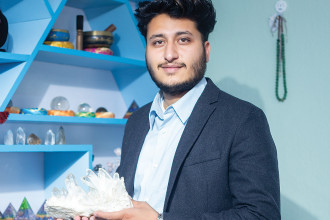
Prashanta Khanal
Co-founder, Raithaane
Raithaane, a unique restaurant which aims to promote and celebrate the diverse ethnic cuisines and ingredients of Nepal, is situated amidst the buzz of the narrow alleys of Patan. The founders of Raithaane, Jason Shah, Mathilde Lefebvre and Prashanta Khanal first met through various traditional and non-traditional food events. “During these food events, we realised that to promote the diverse and ethnic Nepali food we require a space. That’s when Jason Shah, one of our founders proposed the idea of starting a restaurant business in 2018,” says Prashanta Khanal.
Though Khanal completed his Master’s in Environmental Management from Pokhara University, his interest has always been in food. This interest is more specifically focused on Nepali ethnic cuisine, he even runs a blog called gundruk.com where he explores the recipes of ethnic Nepali food in our kitchens, and has written a cookbook titled ‘Timmur: Stories and Flavours from Nepal’ in 2022.
The objective of Raithaane is to bring local ingredients that are often overlooked to life through their recipes. The menu here sets itself apart from most restaurants. From rich ethnic dishes like rikikur (Sherpa potato pancake), batuk (made from black lentils or sometimes from rice beans), chukauni (potato and yogurt salad with mustard seed), chamre bhat (sticky rice), their menu is just not limited to ethnic Nepali foods, they also offer cuisines inspired from other parts of the world. “Most of the ingredients we use in our menu are locally produced. We don’t know the source of two or three spices but apart from that most of our major ingredients like millet and buckwheat are locally sourced. And our vegetables mostly come from Patlegaun, Kavre. We trust our farmers and they assure us that the vegetables are pesticide free,” affirms Khanal.
The seasonality of fruits and vegetables is also reflected in their menus. During winter they have a special orange festival and during the summer, they have mango festival. “During these festivals, buying and selling of oranges and mangoes from our farmers takes place and we also try various recipes using oranges and mangoes. For instance, we make orange tarts, sauces, pies and cakes,” says Khanal.
“It may look simple but the restaurant business is quite challenging,” states Khanal. “The restaurant culture in Nepal has not yet matured enough whereby people go to eat in restaurants on a regular basis. To change the mindset of people that eating outside can be healthy too is a huge challenge,” he shares. Another major challenge is in finding the right chefs. “Culinary schools mostly focus on international and continental foods neglecting our traditional ethnic foods and to find people adept in cooking ethnic Nepali dishes is a herculean task,” he says.
Khanal shares that he is not a professionally trained cook and has taken no cooking class as such. “However, since I have a passion for food and ethnic dishes, I try making dishes myself. I used to train with our chefs as well,” he says.
“Moreover, we are constantly bringing variations and innovations in our menu. In some dishes we use mustard oil instead of regular olive oil. We also use ju-ju dhau (Nepali yogurt) to make pies. We roast coffee in kasaudi (a traditional Nepali utensil). These are some of our innovations that we try to bring the local ingredients to life,” he adds.
Raithaane’s emphasis on preserving the local ingredients is to reflect the Nepali culture, identity and heritage. “If we forget our ethnic food then we will also forget our history and culture. We can even use food to trace back the origin of culture. For instance, momos are a favourite with literally all Nepalis and we can trace back its origin to the 16-17th century traders,” says Khanal, adding that preserving our authentic food culture and taste is a way of preserving our history and culture for the generations to come.
He further says that the importance of preserving local ingredients is not limited to our culture alone but it also has significance in adapting to the changing climatic conditions. “For instance, millet is a drought resilient plant but rice isn’t. So, during the rainy season, if there are fluctuations in the rain pattern then rice will not grow as expected but millet grows as it can adapt to drought. So inculcating millet in our diets can enable us to adapt with climate change,” he explains.
Khanal says, “I have come to the realisation that more such restaurants are needed to promote and celebrate our cuisines. And most importantly we need the media to promote our ethnic foods. We can see that Korean food is gaining huge popularity among the new generation. The reason behind this could be the k-dramas and the Korean culture that are being promoted through media, songs, shows and television series. Similarly, if our media could promote Nepali culture, ethnic Nepali food then we could have more people embrace our food.”
The aim now for the partners is to make Raithaane a sustainable business. “We have been able to breakeven but not earned any profit as such. We have seen how Covid compelled even long-run and established businesses to shut down. Our vision now is to run Raithaane sustainably and we are working on it,” he shares candidly.



-1744695387.jpg)
-1738136553.jpg)
-1735815016.jpg)
